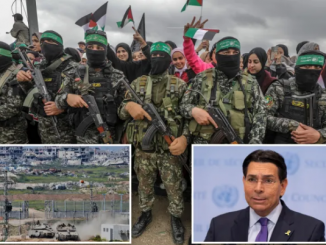
| Published June 11, 2025
A senior Trump administration official told the Washington Free Beacon that the U.S. government has monitored the situation and will protect Americans on the ground in Gaza
Hamas issued threats via Telegram, targeting U.S.-Israeli-backed aid distribution hubs in Gaza—specifically those operated by the newly formed Gaza Humanitarian Foundation (GHF). These messages warned that “agents and mercenaries” collaborating with American aid would be considered legitimate targets. A U.S. official confirmed surveillance of Hamas-affiliated groups and pledged protective measures for American staff on-site.
Context: New Aid Architecture in Gaza
-
Gaza Humanitarian Foundation (GHF)
-
Established late May 2025 by U.S. and Israeli backers as an alternative to UNRWA.
-
By early June, it had distributed millions of meals via guarded hubs in southern Gaza.
-
Reports indicated high casualty rates near these hubs—dozens killed and hundreds wounded—during chaotic distributions, with incidents described as near military zones and involving warning shots.
-
-
UN and Aid Community Response
-
Numerous humanitarian groups refused to partner with GHF, citing violations of neutrality and concerns about militarized delivery.
-
The UN and other bodies raised alarms about forced displacement and constrained access due to centralized hub placement .
-
Hamas’s Position and Messaging
-
Hamas publicly denounced GHF, accusing the initiative of aiming to dismantle UNRWA and facilitate “forced displacement and ethnic cleansing”.
-
In Telegram communiqués, Hamas affiliates urged targeting of “anyone who cooperates with the enemy,” clearly labeling GHF as hostile.
-
They advocated a return to UNRWA and other international channels deemed legally recognized .
-
Hamas also positioned itself as protector of UN-led aid convoys, pledging to deploy forces in its defense.
Ground Realities at Distribution Sites
-
Multiple reports—by Reuters, AP, Al Jazeera, AP—detailed lethal encounters near GHF hubs:
-
At Rafah and Wadi Gaza, crowds seeking aid were met with gunfire, resulting in dozens of casualties.
-
The UN described distributions as resembling “Hunger Games” scenarios, with chaos, lethal injuries, and restricted NGO access.
-
GHF temporarily halted operations in early June following repeated shootings, resuming after security assessments.
-
Support for Local Militias
-
Israel has reportedly armed local factions such as Yasser Abu Shabab’s “Popular Force,” which guards the GHF hubs.
-
These militias have been accused of looting aid trucks—particularly around Kerem Shalom—despite Israeli denial.
-
Abu Shabab, formerly a smuggler, leads anti-Hamas factions but is entangled in controversy over past criminal activity and allegations of looting.
Broader Conflict Landscape
-
The larger backdrop includes ongoing military operations by Israel aimed at weakening Hamas, with cross-border hostilities, sanctions, and mobilization of local militias .
-
International pressure on both sides continues—Western governments have sanctioned Israeli officials for incitement, and aid restrictions remain under scrutiny.
-
Gaza’s humanitarian crisis remains severe. Nearly 2.3 million residents face famine risk, and children show alarming levels of acute malnutrition.
Here are potential implications of the developments described in the original Free Beacon article and broader reporting on the situation in Gaza. These are analytical interpretations and not direct conclusions from any one source.
1. Increased Risk to U.S. and Israeli Aid Personnel
The threats by Hamas to target U.S.-backed aid efforts—particularly those associated with the Gaza Humanitarian Foundation (GHF)—signal a direct risk to American and Israeli staff and contractors operating in Gaza. If attacks materialize, they could deter further involvement by U.S. humanitarian personnel and possibly lead to a drawdown or suspension of operations.
2. Destabilization of Humanitarian Aid Channels
Hamas’s call to target individuals affiliated with the GHF may deepen the fragmentation of aid delivery in Gaza. With many international NGOs already distancing themselves from GHF and the UN’s own operations constrained, this situation could create a vacuum in aid distribution—exacerbating Gaza’s already dire humanitarian conditions.
3. Undermining of UNRWA and International Norms
The creation of the GHF outside the traditional UNRWA framework, and its endorsement by Israel and the U.S., represents a significant shift in how aid is administered in conflict zones. If this model persists, it may signal a broader move by powerful states to bypass UN agencies in favor of bilateral or militarized humanitarian interventions—raising concerns about neutrality, access, and long-term accountability.
4. Hamas Seeks to Reassert Political Legitimacy
By positioning itself as the protector of UN-led aid and declaring opposition to the GHF, Hamas may be attempting to reclaim legitimacy as a governing actor in Gaza. This messaging aims to portray the group as a guardian of Palestinian sovereignty and a check on foreign influence—even as it faces military setbacks and internal dissent.
5. Growing Militarization of Aid
Reports of Israeli-backed militias like the “Popular Force” guarding aid distribution sites—and being involved in alleged looting—suggest an emerging trend of aid becoming a battlefield asset. This militarization could undermine the principle of impartiality in humanitarian relief, making both aid workers and civilians more vulnerable.
6. Possible Erosion of U.S. Humanitarian Credibility
If the GHF continues to face violence, looting, or mismanagement—while being seen as a U.S.-Israeli proxy—it may tarnish the image of American humanitarian efforts. This could affect U.S. soft power in the region and diminish its influence in international diplomatic forums.
Overall Takeaway:
The confrontation over aid distribution in Gaza reflects a deeper geopolitical and humanitarian struggle: who controls access to basic survival in a war-torn region—and what that control signifies. As Hamas threatens U.S.-backed aid hubs and positions itself as the defender of UN-led assistance, the situation reveals the growing militarization and politicization of humanitarian relief. With rising risks to civilians, aid workers, and infrastructure, this standoff underscores a grim truth: in Gaza, even food has become a front line in the broader conflict.
SOURCES: THE WASHINGTON FREE BEACON – Hamas Plans Attacks on US Aid Sites In Gaza, Telegram Messages Show
AP NEWS – Live updates: Israeli ministers sanctioned by UK and other countries over West Bank incitement
REUTERS – US-backed Gaza group suspends aid for a day over threats, Hamas vows to protect UN aid





Be the first to comment